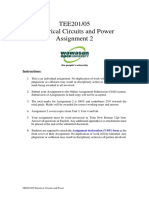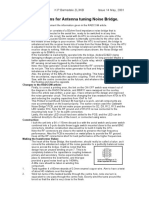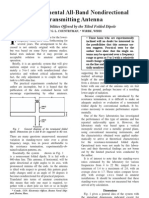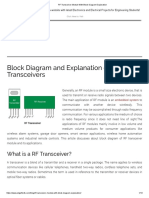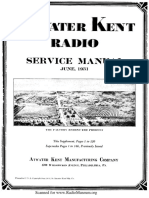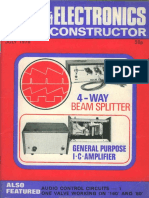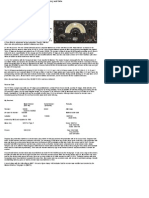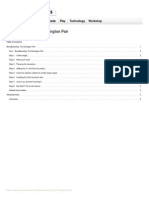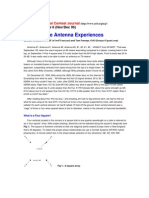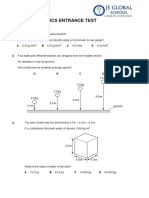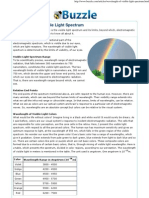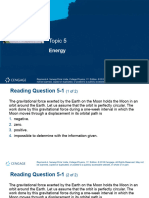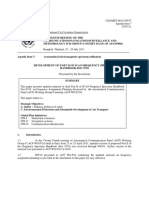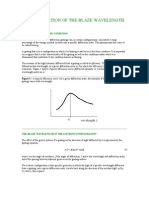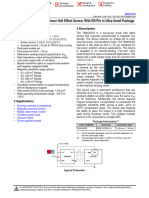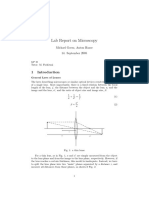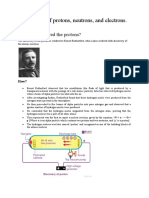10 Meter Vertical Project
10 Meter Vertical Project
Uploaded by
aikido27Copyright:
Available Formats
10 Meter Vertical Project
10 Meter Vertical Project
Uploaded by
aikido27Original Description:
Copyright
Available Formats
Share this document
Did you find this document useful?
Is this content inappropriate?
Copyright:
Available Formats
10 Meter Vertical Project
10 Meter Vertical Project
Uploaded by
aikido27Copyright:
Available Formats
A Ten Meter Vertical Antenna for All License Classes
by Rich KR7W The intent of this article is to show how I built an effective 10 meter vertical antenna. My goal is to reveal, in some kind of logical way, my thoughts, methodology, and how I came up with the final result in an easy to understand way. Hopefully, what I did will inspire others to create their own version of this type antenna Especially since Technician class license holders will soon be able to operate SSB in the 10 meter band. For quite some time now Ive wanted to improve my receiving of signals on 10 meters when checking into the Sunday night net and the Monday night informal CW practice. I wanted to be able to choose between my existing horizontally polarized multi-band dipole and a vertically polarized antenna to receive (and transmit) the best signal. I do know that in VHF there is a difference of 20 to 30 decibels between a horizontally polarized antenna on one end and vertical polarization on the other. So there is a chance of making a big difference in signal strength depending on who I am having a QSO with. I decided to erect a 10 meter half wave vertical on top of my garage where there are already some spare coax cables that route back to my ham shack. I mentioned this project to some of the members at the Saturday gathering at the clubhouse. Someone asked me, Why half wave? Why not a quarter wave arrangement? Quarter wave would not need to be so tall. My answer was that I did not like the radiation pattern of the quarter wave antenna as a lot of the RF energy goes straight up and with the half wave antenna, more of the RF energy is radiated toward the horizon. Also, an effective wave vertical needs a lot of radials to make it efficient. Most hams, including Ole Joe, will attest that the vertically polarized two meter J-Pole antenna is one of the best antennas around. Did
you know that this antenna just happens to be a half wavelength vertical antenna? The J-pole consists of a half wave radiator (the part above the U shaped bottom of the J) with a quarter wave U shaped matching stub. (Diagram 1) The top and bottom ends of the half wave radiator are HI impedance (Hi Z) points. The top of the U shaped matching stub is also HI impedance. The Hi Z ends of the wavelength radiator may not be the same impedance as the stub but it is close enough to work well by adjusting the length of the WL radiator. Somewhere along the bottom of the U stub is a 50 ohm point where the coaxial cable feed line attaches. Note that the U shaped stub does not radiate only the half wave section does the radiating.
Diagram 1 I could build a 10 meter J-Pole but the half wave radiator of 16.5 ft. plus the U shaped stub of 8.5 ft. would be more than 23 feet high and that would be difficult to support atop my garage without guy wires. So my idea is to design a matching stub device that matches the 50 ohm feed line from the rig to the Hi Z end of the half wave 10 meter radiator. Continued on Page 2, Col 1
PAGE 1
10 Meter Antenna article... Joe will attest that the following figure shows how the end of the half wave radiator is high impedance. Notice that the voltage is maximum and the current is lowest at the end of the radiator. Using Ohms law Resistance (or Impedance) is equal to the high voltage (E) divided by the low current (I) which will be a high number. Diagram 3: A circuit like this that is tuned for resonance on the desired frequency will always be hi Z and have a high voltage The search was on to find an inductor (L) and capacitor (C) combination that is resonant at 28.200 MHz.. I found some inch diameter coil stock and some variable capacitors in my junk box and built a circuit like shown. To measure the resonant frequency of the L-C combination I used my MFJ-269 antenna analyzer with a three turn coil of wire plugged into the antenna jack. By placing the MFJ-269s coil next to the tuned circuit and tuning the analyzer I found a dip in SWR reading at 24 MHz. Note: This method works like the Grid Dip Oscillator of vacuum tube days of past. I found that if I reduced the value of C then the frequency would go upwards. I connected the two variable capacitors in series to lower the C value. By adjusting the two caps while the antenna analyzer was set to the desired frequency I located the dip at 28.200. The ARRL handbook also says that I can find the 50 ohm point on the inductor coil by placing a tap somewhere along the length of the coil and the bottom of the coil. Note: this is similar to finding the 50 ohm point on the wavelength U shaped tuning stub on the Jpole antenna. Once the Inductor and Capacitor were at the desired resonant frequency I placed the tuned circuit into an old surplus plastic enclosure. I installed a PL-259 coax jack at the bottom of the box to attach the feed line to the Continued on Page 3, Col 1 PAGE 2
Diagram 2 shows Current VS Voltage along a 1/2 wavelength radiator. There is always high voltage at the end of the antenna.
Ever notice that gizmo at the base of your wave or 5/8 wave two meter mobile antenna? Its a cylinder about 2 to 3 inches tall and about an inch round. Within that gizmo is the 50 ohm to Hi Z matching device. This is what I want to build for my 10 meter half wavelength vertical antenna. I read about RF tuned circuits in the ARRL radio handbook. I found that parallel tuned circuits are very high Z at resonance (where the inductive reactance equals the capacitive reactance) across the circuit. This type of tuned circuit consists of a capacitor in parallel with an inductor. (Diagram 3) I wanted my circuit to be resonant at approx 28.200 MHz, between the CW practice frequency and the Sunday night net frequency, 28.150 and 28.375 respectively.
10 Meter Antenna article...
10 Meter Antenna article... shackand an aluminum stand-off stud on the top of the box to attach the half wavelength radiator. To find the 50 ohm point on the inductor coil I connected a substitute hi Z antenna (a resistor) to the combination of L and C to take the place of the half wave radiator. By guessing I chose a 3.3 K ohm resistor to take the place of the radiator. Why 3.3 K ohms? Well, I remembered that my Icom automatic antenna tuner will match a Z of 5 to 5 K ohms. The closest resistor I had was 3.3K Ohms. (Diagram 4).
from coax cable I needed to find the value of the variable capacitors in the tuned circuit.
Photo 5: The inside of the enclosure reveals the variable tuning caps and the coil. The yellow alligator clip is moved up and down the coil to achieve the best SWR.
Diagram 4: Schematic diagram showing how the 3.3 K resistor substitutes for the antenna wire. Also the possible location of the 50 ohm point that the coax feed line connects I then connected the antenna analyzer set at 28.200 MHz to the PL-259 jack. By moving the clip lead up and down the inductor coil I found the coils 50 Ohm location that gave me a very low SWR. Because of the HI Z and high voltage across the parallel tuned circuitI thought that the small variable trimmer capacitors would arc across which would cause very high SWR and perhaps damage my transmitter. I learned by reading a piece of coaxial cable with an open end is a capacitor. I also realized that coax cable can handle the everyday high voltage of standing waves (VSWR) in a feed line. So to make an equivalent value capacitor
Photo 6 shows the L-C meter and the coax capacitor connected. The L-C meter outputs the value in Morse Code. Continued on Page 4, Col 1
PAGE 3
10 Meter Antenna article... I carefully removed the two variable trimmer caps from the tuned circuit and measured them with my ELSIE-2 L-C meter and came up with 24 pico-farads (PF). Then I prepared an 18 inch piece of RG-58 coax and connected it to the L-C meter. (Photo 6) I measure 88 PF. Reducing the length of the coax reduced the value of capacitance. So, trimming a small bit of coax off and re-measuring finally got it down to 24 PF, which was about 7 inches long. The coaxial capacitor was rolled up and cable tied to fit in the enclosure in place of the trimmer capacitors. (Photo 7)
and the #12 wire enters the box on top via an aluminum stand off. Tuning it up: I set up the whole assembled unit on the picnic table in my back yard and plugged in my antenna analyzer. The best SWR was at 29 MHz. Remembering Lower is Longer from the technician class I needed to make the wire element longer in order to lower the frequency.. So, I added about 24 inches more wire that took me to the best SWR at 27 MHz. Carefully cutting an inch at a time and retesting brought the length of the vertical wire to 17 ft 4 in and I had a SWR of 1.1 to 1 at 28.200 MHz. I had good SWR of 1.4 from 28.000 to 29.000 MHz.
Photo 7 shows the final installation of the coaxial capacitor, the 50 ohm impedance tap on the coil, and the connection to the radiator wire (top of coil). It all comes together The radiating element, a piece of # 12 stranded wire, calculated to be about 17 ft long. To support the wire vertically I taped it to a 20 ft long collapsible fishing pole (left over from another project). I built a small wooden support from scrap lumber that supports the fishing pole vertically (radiator hose type clamps) and provides a place for weights (two cinder blocks) to keep the whole thing on the flat roof of my garage. The plastic box that holds the parallel tuned circuit was screwed to the wooden stand. The coax enters the box via the PL-259 socket on the bottom Photo 8 Final assembly: Plastic enclosure connected to wooden stand and fiberglass fishing pole connected to stand. After placing the antenna assembly at the desired location on the garage roof I measured a poor SWR of worse than 3.0 to 1. Some experimentation determined that I located the antenna too close to some metal flashing and the phone line to our house. By moving the antenna assembly towards the Continued on Page 5, Col 1
PAGE 4
rear of the roof the original good readings were achieved. Testing: In the shack... I connected my rig to the new antenna. At my desired frequencies of 28.150 and 28.375 MHz, using 50 watts output I measured SWR or around 1.25 (or less) to 1. At 28.001 to 29.000 MHz I read about 1.4. At 29.699 (the end of the band) the SWR was over 2.5 but my radios internal tuner adjust it down to 1.0 On the 2 meter repeater I asked for others to listen for me at 28.150 MHz, take a reading on the original multi band dipole and then take a reading on the new vertical. Three folks rated the vertical as stronger with the best difference of 1 S-unit, which equates to twice the power received (3 dB). I suspect the higher readings with the new vertical antenna are not because of vertical VS horizontal polarization but because the multi-band dipole (with tuner) is like the Swiss Army Knife of antennas where it does a lot of functions (multiple bands) OK and the vertical antenna is self resonant and more efficient for this purpose. Conclusion: If you choose to build a 10 meter vertical antenna like this one please know that it does NOT have to be exactly the same. A 17 ft wire hanging from a tree or other high object will substitute for the fishing pole I used. The coax cable matching unit could be built in a small Tupperware like container. A Toroid inductor or a coil of wire wound on an discarded pill bottle would make a nice tuning coil. There are lots of possibilities and a lot of information in books and on the web at your disposal. Also, please dont forget there is a wealth of knowledge at your radio clubs gathering spot: The Clubhouse or the 2 meter repeater. So, Joe be safe in that tree or atop that ladder and thanks for reading this far. 30- Rich Kr7w.
PAGE 5
You might also like
- Sb220 Compendium Va7jw Rev2Document40 pagesSb220 Compendium Va7jw Rev2FrankNo ratings yet
- MW0JZE G3TXQ Broadband Hexagonal Beam Assembly Manual-18Document10 pagesMW0JZE G3TXQ Broadband Hexagonal Beam Assembly Manual-18Marcos MillerNo ratings yet
- Phys 158 Final Exam PackageDocument35 pagesPhys 158 Final Exam PackageIsha ShuklaNo ratings yet
- RS BA1 Version2Document2 pagesRS BA1 Version2scsehNo ratings yet
- User's Guide: RF Toolbox™Document786 pagesUser's Guide: RF Toolbox™Amardeep KumarNo ratings yet
- A2 Electrical Circuits and Power Jan 2021Document34 pagesA2 Electrical Circuits and Power Jan 2021narenmaniam0% (1)
- High End Fed1Document7 pagesHigh End Fed1Weerut Srhidhara100% (1)
- article-STL Magnetic LoopDocument7 pagesarticle-STL Magnetic Loopemulador05No ratings yet
- Antune Build InstructionsDocument4 pagesAntune Build InstructionsmvannierNo ratings yet
- An Experimental All-Band Nondirectional Transmitting Antenna - T2FDDocument2 pagesAn Experimental All-Band Nondirectional Transmitting Antenna - T2FDagressorbrNo ratings yet
- Flashing Display Yaesu frg8800Document1 pageFlashing Display Yaesu frg8800JuanManuelGomez0% (1)
- J Pole HandbookDocument10 pagesJ Pole HandbookMR XNo ratings yet
- FT-817 Mods: Battery Mod For ft-817Document43 pagesFT-817 Mods: Battery Mod For ft-817Arturo MejiaNo ratings yet
- Understanding Spey Lines: by Simon GawesworthDocument21 pagesUnderstanding Spey Lines: by Simon GawesworthGoparking SpofreetinfoNo ratings yet
- 4nec2 TutorialDocument5 pages4nec2 Tutorialphanvanvinh86No ratings yet
- Commercial-Style CP Dipole FMDocument5 pagesCommercial-Style CP Dipole FMStephen Dunifer100% (2)
- A Superregen Receiver For FM Broadcast or Aircraft Band AM ReceptionDocument4 pagesA Superregen Receiver For FM Broadcast or Aircraft Band AM ReceptionNestor EscobarNo ratings yet
- Wide Band RF TransformersDocument13 pagesWide Band RF Transformerskbdstl1No ratings yet
- Charging Lithium Batteries Using Lead Acid ChargersDocument2 pagesCharging Lithium Batteries Using Lead Acid Chargersحسن علی کاشمیریNo ratings yet
- RF Transceiver Module With Block Diagram Explanation PDFDocument13 pagesRF Transceiver Module With Block Diagram Explanation PDFshahab idreesNo ratings yet
- Came Wiring PlanDocument6 pagesCame Wiring PlanquailpieNo ratings yet
- Atwater Kent Manual 1931 OcrDocument45 pagesAtwater Kent Manual 1931 Ocrpete leoniNo ratings yet
- RC 1976 07Document67 pagesRC 1976 07Jan PranNo ratings yet
- RC 1976 09Document66 pagesRC 1976 09Jan PranNo ratings yet
- Clegg 99 ErDocument10 pagesClegg 99 Erdon_dubuque100% (1)
- Multiband Wire AntennasDocument31 pagesMultiband Wire AntennasAriel BecerraNo ratings yet
- Nw3z Antenna DesignsDocument19 pagesNw3z Antenna DesignsWillowNo ratings yet
- Pro Catalog FinalDocument12 pagesPro Catalog FinalPatrick NowickNo ratings yet
- Submitted By: Rajat Garg C08541 EECE, 7th SemDocument22 pagesSubmitted By: Rajat Garg C08541 EECE, 7th Semrajatgarg90No ratings yet
- Wapsi Catalog Materiale2011Document84 pagesWapsi Catalog Materiale2011Ioan CovaliovNo ratings yet
- RAF Aircraft Radio Receiver Marconi R1155 History and DataDocument2 pagesRAF Aircraft Radio Receiver Marconi R1155 History and DataCorsair58100% (3)
- Coax StubsDocument13 pagesCoax Stubscarlos_gomes_31No ratings yet
- Trans GuanellaDocument12 pagesTrans GuanellaNicola RizziNo ratings yet
- Breadboarding The Darlington PairDocument7 pagesBreadboarding The Darlington Pairmarius_danila8736No ratings yet
- Antenna and Ground SystemDocument8 pagesAntenna and Ground SystemDefaultAnomolyNo ratings yet
- Inexpensive 17-Meter VerticalDocument10 pagesInexpensive 17-Meter VerticalSwlVUNo ratings yet
- Wire Antenna Modelling With NEC-2Document10 pagesWire Antenna Modelling With NEC-2Raden Adhi Ramdhani MegantaraNo ratings yet
- Antenna and Wave PropagationDocument3 pagesAntenna and Wave PropagationPushpendra Singh Rathore0% (1)
- Antenna Analysers How To Use Them Addendum Impedance Conversion CalculatorsDocument2 pagesAntenna Analysers How To Use Them Addendum Impedance Conversion CalculatorsJohn Howard Green100% (2)
- Lab Notes: Multiband Dipoles ComparedDocument4 pagesLab Notes: Multiband Dipoles ComparedJoão Miguel100% (1)
- Ranenote: Grounding and Shielding Audio DevicesDocument17 pagesRanenote: Grounding and Shielding Audio DevicesShiva Prakasam PernetiNo ratings yet
- Upthecoax 3Document6 pagesUpthecoax 3Nicola RizziNo ratings yet
- Building A Yagi Antenna For UHF - J-Tech Engineering, LTDDocument15 pagesBuilding A Yagi Antenna For UHF - J-Tech Engineering, LTDRobert GalargaNo ratings yet
- Project Title: Dipole AntennaDocument3 pagesProject Title: Dipole Antennamubbashir abdullahNo ratings yet
- HMEdedelingen 1206Document32 pagesHMEdedelingen 1206Huong-Helen NgoNo ratings yet
- FM Radio ReceiverDocument3 pagesFM Radio ReceiverRajat100% (1)
- Super Duper MoxonDocument8 pagesSuper Duper Moxonrus comaresNo ratings yet
- A Homebrew Yagi For 1296 MHZ DX: by Heinrich F. Reckemeyer, Dj9Yw - Dj9Yw@T-Online - deDocument5 pagesA Homebrew Yagi For 1296 MHZ DX: by Heinrich F. Reckemeyer, Dj9Yw - Dj9Yw@T-Online - dejorgejbaNo ratings yet
- ARRL - QRP PowerDocument1 pageARRL - QRP PowerEstefanía DerNo ratings yet
- Packet RadioDocument10 pagesPacket Radiopdf.unlisted046No ratings yet
- 40 Meter Mini MOXON Beam Antenna PDFDocument26 pages40 Meter Mini MOXON Beam Antenna PDFRahman EffendiNo ratings yet
- Introduction To Amplifier DesignDocument6 pagesIntroduction To Amplifier Designdragos62bondar100% (1)
- 4 Square 80mDocument5 pages4 Square 80mTRYONLANHOUSENo ratings yet
- DRO-550 Construction GuideDocument23 pagesDRO-550 Construction GuidePeterNo ratings yet
- MFJ 969 Atu Test by Zs1jhgDocument1 pageMFJ 969 Atu Test by Zs1jhgJohn GreenNo ratings yet
- A Ten Meter Vertical Antenna For All License Classes: by Rich KR7WDocument5 pagesA Ten Meter Vertical Antenna For All License Classes: by Rich KR7WFredd dosNo ratings yet
- Delta Loop Skywire Antenna 80m - 10mDocument1 pageDelta Loop Skywire Antenna 80m - 10mPablo J Calderon VNo ratings yet
- Am CircuitsDocument14 pagesAm CircuitsIngkz Jerae100% (1)
- AM Receiver: Home Analysis Help Media Links PracticalDocument10 pagesAM Receiver: Home Analysis Help Media Links PracticalĐinh Văn HiếuNo ratings yet
- AM ReceiverDocument7 pagesAM ReceiverNguyen Manh TuanNo ratings yet
- Loop AntennaDocument12 pagesLoop Antennaalkesh.eng100% (2)
- STEM: Science, Technology, Engineering and Maths Principles Teachers Pack V10From EverandSTEM: Science, Technology, Engineering and Maths Principles Teachers Pack V10No ratings yet
- Complete Download The Quantum Divide Why Schrodinger S Cat Is Either Dead or Alive 1st Edition Christopher C. Gerry PDF All ChaptersDocument48 pagesComplete Download The Quantum Divide Why Schrodinger S Cat Is Either Dead or Alive 1st Edition Christopher C. Gerry PDF All Chaptersshilahpaloan81100% (4)
- Entrance Test AS PhysicsDocument6 pagesEntrance Test AS PhysicsKarthik SNo ratings yet
- Brochure Cmce Sertec 2022 EngDocument12 pagesBrochure Cmce Sertec 2022 Englumoodley100% (1)
- PHY 101 Introduction 1aDocument30 pagesPHY 101 Introduction 1ajohnbello1357No ratings yet
- Standard PricelistDocument4 pagesStandard Pricelistkaruna1342No ratings yet
- Wavelength of Visible Light SpectrumDocument2 pagesWavelength of Visible Light Spectrumshubhamgarg2222No ratings yet
- 05 - CH Serway 9781305952300Document75 pages05 - CH Serway 9781305952300Renée PetersNo ratings yet
- 05 Oscillations and WavesDocument6 pages05 Oscillations and WavesMusharaf SwaliNo ratings yet
- 02 - TPG CT Trafo BayDocument1 page02 - TPG CT Trafo BayBram AzaryaNo ratings yet
- Circuit TestingDocument22 pagesCircuit TestingAlexandre OliveiraNo ratings yet
- Lecture 3 - Structures of Transmission Lines, May 2022Document91 pagesLecture 3 - Structures of Transmission Lines, May 2022Ssegirinya WilberforceNo ratings yet
- IP37 - ICAO AI. 7 - Radio Freq Spectrum Handbook Part II PDFDocument152 pagesIP37 - ICAO AI. 7 - Radio Freq Spectrum Handbook Part II PDFTejas RathodNo ratings yet
- Determination of The Blaze WavelengthDocument3 pagesDetermination of The Blaze Wavelengthakshay88No ratings yet
- Physics Class 12th Practical Viva Question With Answer in English MediumDocument7 pagesPhysics Class 12th Practical Viva Question With Answer in English MediumKallol SahaNo ratings yet
- Midweek 33 Answer KeyDocument4 pagesMidweek 33 Answer KeyDessNo ratings yet
- V60 ... V63, 3/2, 2 X 3/2, 5/2 or 5/3 Solenoid and Pilot Actuated Spool ValvesDocument19 pagesV60 ... V63, 3/2, 2 X 3/2, 5/2 or 5/3 Solenoid and Pilot Actuated Spool ValvesRian PratamaNo ratings yet
- Electricity MCQ TestDocument9 pagesElectricity MCQ TestChandra SekarNo ratings yet
- Basic Electronics Lab 1Document22 pagesBasic Electronics Lab 1Mary Joy Borbo PantojaNo ratings yet
- Curriculum Map Science 10 Quarter 1Document2 pagesCurriculum Map Science 10 Quarter 1jao orevilloNo ratings yet
- Mass SpectrosDocument72 pagesMass SpectrosUnknownuser YetNo ratings yet
- Group Theory and PhysicsDocument252 pagesGroup Theory and PhysicsArt Rmbd100% (1)
- DC Motor Simulink ModelDocument1 pageDC Motor Simulink Modelammp2011No ratings yet
- Presentation Summer TrainingDocument9 pagesPresentation Summer TrainingSamarth RajpootNo ratings yet
- 15-07-2023 - Sr. C-IPL - Jee-Mains - WTM-10 - Q PaperDocument16 pages15-07-2023 - Sr. C-IPL - Jee-Mains - WTM-10 - Q PaperAnirban RoyNo ratings yet
- Tmag 5253Document35 pagesTmag 5253Ali Younis69No ratings yet
- Assessment 1 - Questioning - Written Assessment - AURETR130Document26 pagesAssessment 1 - Questioning - Written Assessment - AURETR130Zara ManNo ratings yet
- Lab Report On Microscopy: Michael Goerz, Anton Haase 14. September 2005Document5 pagesLab Report On Microscopy: Michael Goerz, Anton Haase 14. September 2005ELLY BILGRAMNo ratings yet
- Discovery of Sub Atomic ParticlesDocument4 pagesDiscovery of Sub Atomic ParticlesManasvi SharmaNo ratings yet





